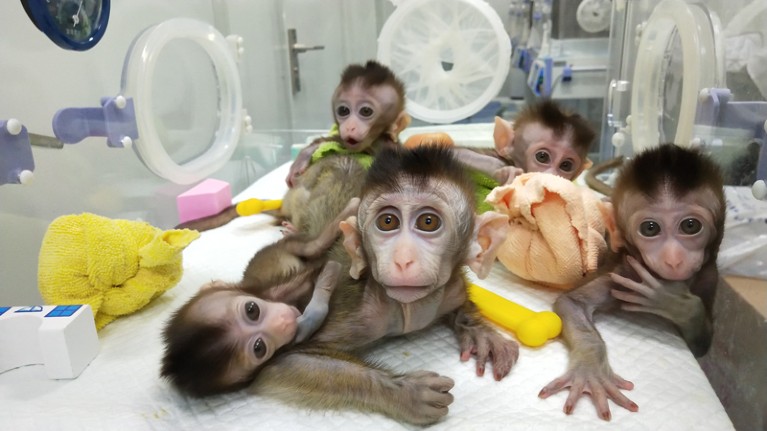Hello Nature readers, this is the news that matters in science today. You can also sign up to get it free in your inbox.

These cloned macaque monkeys are almost genetically identical, and share a mutation that disrupts their sleep cycle. Credit: Institute of Neuroscience, Chinese Academy of Sciences
First cloned gene-edited monkeys
For the first time, researchers have cloned a gene-edited monkey: a macaque (Macaca fascicularis) with a disabled gene that is crucial to the sleep–wake cycle. The work might lead to populations of genetically identical primates that could be used for biomedical research. Cloned primates could provide improved animal models of human disease, but some researchers raise ethical issues.
Reference: National Science Review paper
Small Kuiper-belt rock spotted with amateur gear
Astronomers have used amateur telescopes to observe a 1.3-kilometre rock at the edge of the Solar System. The Kuiper belt is thought to be packed with bodies between 1 and 10 kilometres in size left over from the early formation of the Solar System, but this is the first time one has been detected. The silhouette of the unnamed rock was observed as it passed in front of stars, since it’s too small and far from the Sun to see otherwise. In January, NASA’s New Horizons spacecraft captured close-ups of space rock 2014 MU69 — the most distant world ever visited by humanity — which is around 32 kilometres long by 16 kilometres wide.
Reference: Nature Astronomy paper
Gum-disease bacteria linked to Alzheimer’s
Scientists have found the key bacteria that causes gum disease — Porphyromonas gingivalis — in the brains of people with Alzheimer’s disease. (They also found P. gingivalis in about half of the brain-tissue samples they looked at from people who didn’t have Alzheimer’s.) And, when researchers infected the mouths of eight mice with the microbe, it triggered brain changes typical of Alzheimer’s in people. The finding supports evidence that the amyloid plaques associated with Alzheimer’s might arise from the brain’s attempts to defend against bacteria — particularly those that cause gum disease, which is known to be a major risk factor for the condition.
Reference: Science Advances paper
FEATURES & OPINION
The life-science technologies to watch
From high-resolution imaging to genome-sized DNA molecules built from scratch, the future looks exciting for life-science technology. Seven specialists tell Nature the developments that will push their fields forward in the year ahead.
How to team up with big tech
Technology-industry funding can offer ready money to move your research forward — if you can overcome the limitations of working with private businesses, such as non-disclosure agreements. “From our perspective, it’s free money,” says Florian Metze, a computer scientist who has received funding from Google, Facebook and Amazon.
Looking back on Primo Levi’s The Periodic Table
In his “hymn to the elements”, chemist Primo Levi shows how “chemistry shapes his life, defines his life, and in Auschwitz even saves his life”, writes Tim Radford, who reviewed the memoir’s first translation into English more than thirty years ago. On the 150th anniversary of the titular table, Radford celebrates the extraordinary short-story collection that delivers “a sharp sense of the compulsion, ambiguities and delights of science”.
